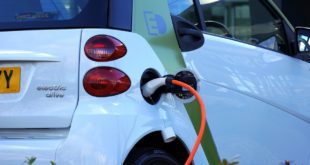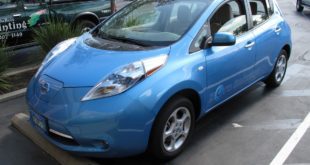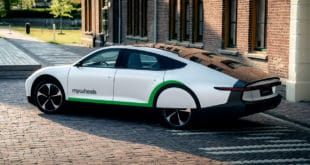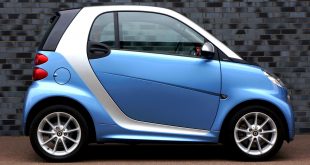
Is an Electric Car Right for You?
Operating a car without needing to visit a gas station is intriguing idea to many American drivers. After all, the pumps can be a painful place—gas prices have been on a roller coaster ride the past few years. But in the minds of many American, electric cars are nothing more than glorified golf cars incapable of providing adequate daily driving range or sufficient highway speed. In this new era of electrified transportation, those misconceptions need to be tossed aside.
Todays’ electric vehicles, like the Nissan Leaf, provide all the creature comforts and capabilities of gasoline internal combustion cars. These EVs comfortably seat four or five passengers, offer quasi-luxury features, and serve up smooth, silent and sporty levels of acceleration. But there are a couple of important issues to consider—such as driving range and refueling times.
Are There Drawbacks To Consider?
Except for top-of-the line expensive models like the Tesla Model S (shown above), which offers 250 or more miles of range on a single charge, most of the new EVs commonly provide about 80 to 100 miles of travel after receiving a full charge.
Actually, the average distance traveled by commuters in the U.S. is about 30 miles. So EVs provide plenty of range for the most common routes. The limitation only becomes an issue for single-car families or those who regularly go on a road-trip of hundreds of miles. If you are a road warrior who takes long trips all the time—or have a daily commute of more than 60 or 70 miles—an electric car is probably not right for you.
For everybody else, an EV is a refreshing break from the petro-dominated past.
Unlike a gas car that refuels at a gas station in a matter of minutes, an electric car commonly takes a few hours to fully recharge. This is mostly overstated as a concern because your car is almost always parked overnight while you sleep. That’s the perfect time to charge, so that you can wake up with a full 80 to 100 miles of driving in front of you. It’s as easy as pulling into your driveway or garage, reaching for the cord, and plugging it in. This might be challenging for folks without a dedicated parking spot, but for most drivers, charging an electric car is more convenient than making those dreaded trips to a gas station.
What Are the Top Models?
The two top electric models today are the Nissan Leaf and Chevrolet Volt. Keep in mind that not all electric cars are created the same. The Nissan Leaf is a pure electric car, while the Chevrolet Volt is what General Motors calls “an extended-range electric vehicle.” This is also referred to as a plug-in hybrid—meaning that the first set of miles, after a charge, are provided by batteries and an electric motor, after which a gas engine is used to extend range by hundreds of miles. Other plug-in hybrids include the Ford C-Max Energi, Fisker Karma, and Toyota Prius Plug-in Hybrid.
Chevrolet Volt
The Chevy Volt is a well-equipped, five-door, four-seat hatchback that operates as an electric car for its first 37 or so miles after a full charge—and then uses gas to extend its range.
Ford Focus Electric
The five-door hatchback provides about 80 miles of range. It features higher speed charging than many competitors—as well as liquid cooled/heated batteries for maintaining range in hot and cold weather. Availability is somewhat limited.
Nissan Leaf
Nissan’s groundbreaking electric car is the most popular EV ever produced. It comfortably seats five adults and is loaded with high-tech luxury-like features. As of summer 2012, the Leaf is available to test-drive and purchase at Nissan dealerships throughout the United States.
Tesla Model S
The full-size Model S sedan has swept awards for Car of the Year in 2012. It’s not only the most capable, comfortable, luxurious, and sporty EV on the road, it beats nearly every gas-powered sedan on all these same categories. Range, with its largest battery pack, is more than 250 miles on a charge. Expect a high price tag, and a wait of at least a few months.
Toyota Prius Plug-in Hybrid
The Toyota Prius Plug-in Hybrid’s 4.4 kilowatt-hour battery pack provides 11 or more all-electric miles after a full charge. As a result, drivers with short commutes commonly get more than 100 miles per gallon. After the battery is depleted, the car works just like a conventional hybrid, providing about 50 miles per gallon.
Where Do I Get Fuel?
Electricity is ubiquitous in the United States. So charging an electric vehicle is as close as your nearest electric receptacle. For plug-in hybrids, you’ll only ever really 110-volt charging (using the cord set provided with the car). For pure electric cars with larger batteries, you’ll likely want to install a piece of hardware referred to as “electric vehicle service equipment,” that can provide a 220-volt supply of juice. The public charging infrastructure is in its infancy, but if you live in one of the major markets for electric cars, you’ll discover hundreds of local charging spots.
How Much Does the Fuel Cost?
As a rule of thumb, miles of travel on electricity are between one-fourth to one-sixth the cost of gasoline or diesel. That means returning to the days of (the equivalent of) one dollar a gallon. Some public EV charging is slightly more expensive, but by and large, the price advantage of using electricity as an automotive fuel is dramatic.
Are Electric Cars Green?
Regardless of how your local electricity is produced—whether by coal, hydro, nuclear or renewables—driving an electric car is as green as a motorist can get. That’s because EVs are very efficient, using as much as 90 percent of onboard electricity (stored in batteries) as propulsion for the wheels—compared to gasoline internal combustion engine vehicle that use only a small percentage of its fuel to move the car down the road. The rest of that energy is wasted as heat or, unfortunately, tailpipe emissions.
As time passes, and our electric grids increasingly use renewables, such as wind and solar, the environmental profile of EVs will become even greener. Many of today’s electric cars have home photovoltaic (solar) systems, so they can essentially power their electric cars with sunshine today.
Article by Brad Berman, appearing courtesy ebay Green Driving.
 Alternative Energy HQ solar power for homes, wind energy, and bio fuel issues
Alternative Energy HQ solar power for homes, wind energy, and bio fuel issues











